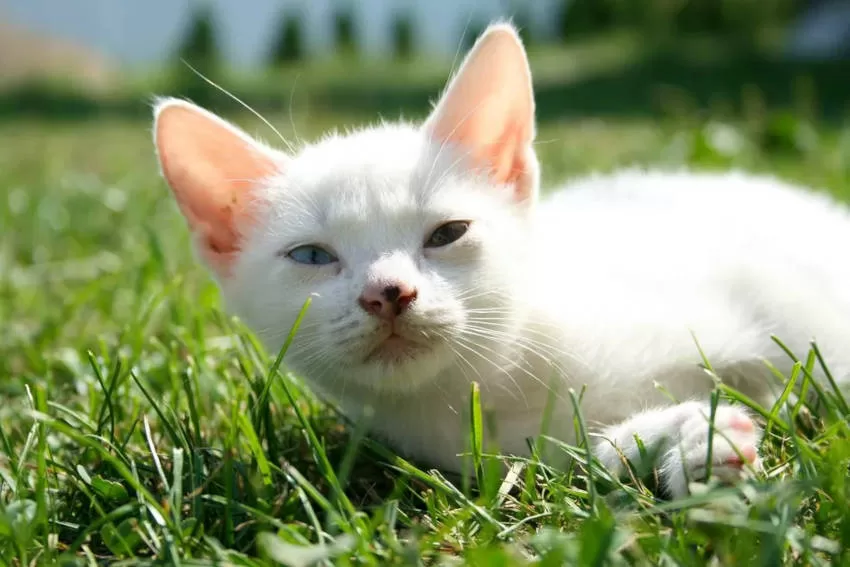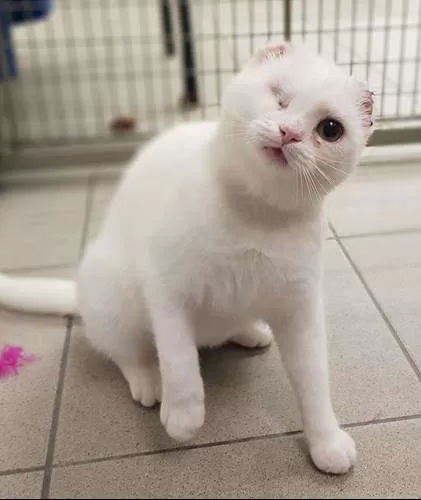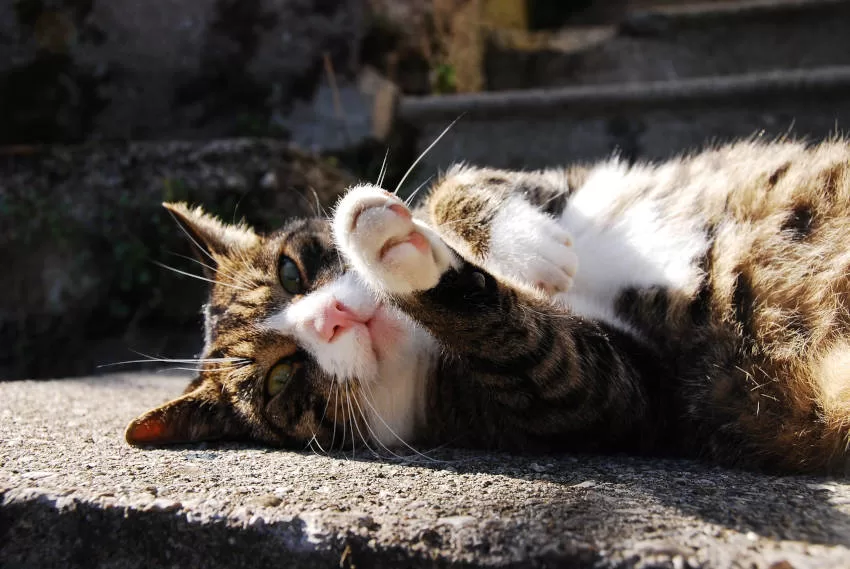Introduction to Preventing Sunburn in Cats
Did you know that your pet can suffer from sunburn? Yes that’s right. Despite the common myth that cats are immune to this type of problem, the truth is that they also need to protect themselves from excessive heat and UV rays.
Sun prevention is essential for feline health. However, many owners make the mistake of underestimating the risks associated with excessive sun exposure in cats. The first tip is: use pet-specific sunscreen! And remember, when the temperature is too high, keeping your furry friend out of the sun isn’t just a comfort issue – it’s a health issue. So stay tuned and take good care of your cat this hot season!
Identification of Cats with Greater Sun Risk
Physical Characteristics and Solar Risk
There are some physical characteristics that can make your cat more vulnerable to the sun. For example, cats with light or thin coats are more susceptible to sunburn. This is because fair skin absorbs more sunlight, which can lead to sunburn. Additionally, hairless or short-haired cats are also at a higher risk.
- White Cats: White cats are particularly prone to sunburn.
- Hairless Cats: Breeds like the Sphynx don’t have hair to protect their skin from the sun.
- Short-haired cats: Even short-haired cats, such as the Siamese, may be at increased risk.

Most Prone Breeds
Some cat breeds seem to be more prone to sunburn than others. Hairless or very finely coated breeds are at the top of the list. That includes:
- sphynx
- devon rex
- cornish rex
- siamese
However, any cat can get a sunburn if it spends enough time in the sun without adequate protection.
Behavior and Exposure to the Sun
Behavioral attitudes can also indicate whether a cat is more likely to be exposed to the sun. Cats who spend a lot of time outdoors during peak hours of the day are at greater risk.
Warning signs include:
- Spending long periods outdoors between 10 am and 4 pm.
- Sleep often in sunny areas indoors.
- Refusing to use pet sunscreen (yes, it exists!).
But remember: even indoor cats can suffer sun damage if they frequently sleep near windows during the day.
Therefore, it’s important to be aware of the physical and behavioral factors that can put your feline at risk when it comes to sun exposure and to adequately protect your pet from possible sunburn – because they are part of the family and deserve all the necessary care!
Special Care for Hairless Cats
Extra Protection is Essential
Hairless cats, or cats with light coats, need extra protection. Just like humans, these pets have sensitive skin and are more susceptible to sunburn. Cats’ fur acts as a natural shield against UV rays, so those with less or no fur need extra care.
- Apply animal-specific sunscreen to exposed areas
- Avoid exposure to the sun at peak hours
- Provide adequate shade indoors and outdoors
Specific Recommendations for Skin Care
Caring for your hairless cat’s skin is not as different as caring for your own skin. In addition to sunscreen, there are other types of products that can help:
- Moisturizers: Help keep the cat’s skin hydrated.
- Special shampoos: Keep the pH balanced and avoid dermatological problems.
- Soothing lotions: Help recovery after excessive sun exposure.
Always remember to check that the product is safe for use on animals before applying it to your pet.
Regular Veterinary Monitoring
Regular veterinary monitoring is essential to detect any problem early. Veterinarians can examine the ears, nose and other sensitive areas where problems usually first appear.
Some signs that your cat may be suffering from sunburn include:
- Redness or swelling in the skin
- Agitated or uncomfortable behavior
- Changes in skin color or texture
Be proactive in your pet’s health care and keep your veterinary appointments up to date.
Therefore, protecting your cat from sunburn requires close attention to detail and constant commitment. Remember: prevention is always better than cure!
Practical Tips to Avoid Sunburn
Sunscreens for Felines
The first crucial tip is the correct use of cat-specific sunscreens . Yes, they exist! And they are essential to prevent sunburn in your feline. Just like us humans, cats also need protection from the sun’s ultraviolet rays.
Cat sunscreens are made with safe ingredients that won’t harm your cat’s sensitive skin or cause irritation if ingested during grooming. When applying sunscreen, focus on the most vulnerable areas like the ears and nose.

Restriction of Access to the Outside
Another effective measure is to restrict your cat’s access to the outside during the hours of greatest sunlight intensity. Generally, this period occurs between 10:00 in the morning and 16:00 in the afternoon. During this time, it is recommended to keep the cat indoors or in a shaded area.
- If you have a secure yard, you can install a sunshade net.
- For those who live in an apartment, it is worth investing in protective film on the windows.
Benefits of Shades and Cool Places
Finally, providing shade and cool places also helps a lot in preventing sunburn:
- Trees and shrubs can provide natural shade in the garden.
- Indoors, make sure there are places where direct sunlight does not reach.
- Another option is to use a fan or air conditioner to keep the indoor environment cool.
Remember: prevention is always better than cure! Protecting your cat from sunburn not only prevents discomfort for your cat but also prevents serious health problems in the long run.
Risk Zones for Sun Exposure in Cats
Vulnerable Areas
Cats have specific areas of their bodies that are more vulnerable to exposure to sunlight. These include:
- Ears
- Nose
- Eyelids
- Abdomen, especially in short-haired or sparsely coated cats.
These areas are particularly sensitive as they are less protected by the animal’s coat. Continuous, unprotected exposure can lead to severe sunburn and even the development of skin cancer.
Consequences of Prolonged Exposure
Prolonged exposure to the sun’s rays, especially during peak hours (generally between 10 am and 4 pm), can have serious consequences for your cat’s health. In addition to painful sunburns, the risk of developing precancerous lesions or even skin cancer increases significantly.
It is therefore important to protect your cat during these times, either by keeping them indoors or by providing adequate shade if they are outdoors.

Visible Signs of Sun Damage
Sun damage can manifest itself through various visible signs on your cat’s skin. These include:
- Redness or inflammation in exposed areas.
- Discoloration or change in skin texture.
- Wounds or ulcers that do not heal.
- Abnormal growths on the skin.
If you notice any of these symptoms in your cat, it’s important to seek veterinary care immediately. The sooner sun damage is detected and treated, the better the prognosis for your feline friend.
Remember: prevention is always the best way to protect your cat from sunburn. So be aware of the most vulnerable areas of his body and take steps to minimize his exposure to the sun during the most dangerous times of the day.
Proper Treatment of Sunburn in Cats
First aid
Identifying a possible sunburn on your pet is the first step towards effective treatment. A cat’s fur can be deceptive, but pink or reddened skin, especially in less furry areas like the ears and nose, could indicate a sunburn. If you notice these signs:
- Move your cat to a cool, shaded spot right away.
- Apply cold compresses to the affected area.
- Avoid using any type of ointment or cream without consulting a veterinarian.
Seeking Veterinary Help
If redness persists for more than 24 hours, or if your pet has blisters, it’s time to seek professional help. In these cases:
- Contact your veterinarian immediately.
- Describe the symptoms accurately.
- Follow the professional’s instructions exactly.
Treatment may include anti-inflammatory medications, specific ointments and even surgical intervention in severe cases.
Relieving Animal Discomfort
Sunburn can cause your cat a lot of discomfort. Here are some safe and effective ways to ease your pain:
- Keep it in cool, shaded places: This prevents the burn from getting worse.
- Hydration: Make sure he is drinking enough water.
- Protective clothes: There are special clothes for pets that protect against UV rays.
Always remember: prevention is better than cure! Therefore, keep your cat protected from excessive sun, especially between 10 am and 4 pm when UV rays are strongest.
In short, quickly identifying a possible sunburn on your pet is crucial to starting proper treatment right away. Always consult a professional when you have questions about your cat’s health – they are trained experts ready to help!

Effective Sun Protection Strategies for Cats
Protective Accessories
Cat sun protection can start with something as simple as using accessories. Clothes and protective hats can be an option, as long as they are well tolerated by the animal. It is important to remember that each cat is an individual with their own preferences and tolerances.
- Clothes: These can be made from lightweight, breathable fabrics, allowing the cat to stay cool while blocking harmful sun rays.
- Hats: While it can be challenging to get a cat to wear a hat, they can provide additional protection for the cat’s head and ears.
Adaptations in the Home Environment
In addition to accessories, adaptations in the domestic environment are also essential for feline sun protection.
- Shade Available: Make sure there are always shady areas available for your cat to retreat from the sun.
- Avoid peak solar hours: Keep your cat indoors during times when the sun is strongest, usually between 10 am and 4 pm.
- Sunscreen on windows: Applying a protective film to windows can help reduce the amount of UV radiation entering your home.
Owner Education
Last but not least, educating owners about the dangers of overexposure to the sun is crucial.
Excessive exposure to the sun: It can lead to problems like skin cancer in cats. UVA and UVB rays are particularly harmful.
White or light colored cats: They are especially vulnerable to sunburn because of the lack of pigmentation in their skin and fur.
Regular protection: Just as we humans need protection from the sun, our feline friends do too!
Remember: The best medicine is always prevention! Be mindful of your feline friend’s needs when it comes to protecting against sunburn.

Conclusion: The Importance of Feline Sun Protection
Sun protection for cats is serious business. Identifying cats with the highest sun risk, such as those without hair, is the first step in maintaining your pet’s health. The risk areas for sun exposure in cats are mainly the ears and nose, so keep an eye out!
Don’t forget practical tips to prevent sunburn, such as limiting sun exposure during the hottest hours of the day and using cat-specific sunscreen. If a burn occurs, knowing the proper treatment is essential.
Always remember that prevention is better than cure! Implement effective sun protection strategies and ensure your feline’s health and well-being.
Let’s go! Take good care of your furry friend, he counts on you!
Common questions
What sunscreen can I use on my cat?
To protect your cat from UV rays, always use animal-specific sunscreens. Humans may contain ingredients that are toxic to them.
How can I tell if my cat has a sunburn?
Signs of sunburn in cats include redness, swelling, or blisters on sun-exposed skin — especially on the ears and nose.
Does my cat need sun protection even indoors?
Yes! UVA rays can penetrate windows and cause damage to your felines’ skin even indoors.
When is the best time for my cat to sunbathe?
The safest hours are before 10am and after 4pm. Avoid sun exposure between these times when UV rays are strongest.
Do hairless cats need special sun care?
Yes! Hairless cats have very sensitive skin and are more prone to damage from UV rays. They need extra care like constant use of sunscreen and less time exposed to the sun.
External Links:

